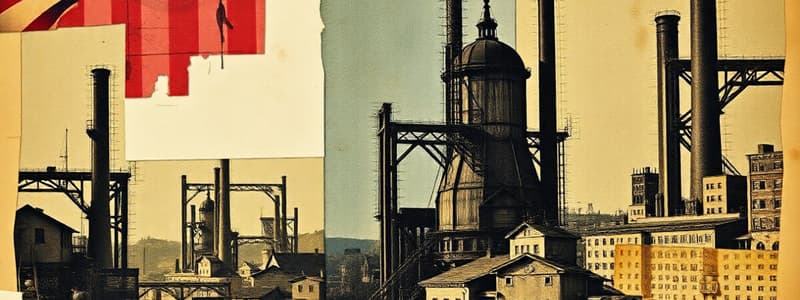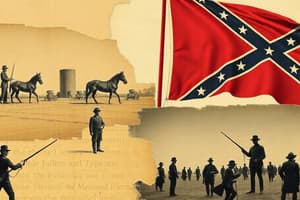Podcast
Questions and Answers
What was a significant consequence of the Industrial Revolution in the U.S.?
What was a significant consequence of the Industrial Revolution in the U.S.?
- The end of agricultural practices across the country
- A decline in the population of the North
- A major increase in farming exports
- The emergence of factories and the growth of cities (correct)
What did the phrase 'Cotton is King' signify?
What did the phrase 'Cotton is King' signify?
- The economic importance of cotton to the Southern economy (correct)
- The decline of cotton production in the South
- A call for the abolition of slavery in the South
- The significance of cotton exports to Northern factories
What was the primary aim of the American Colonization Society?
What was the primary aim of the American Colonization Society?
- To abolish slavery in the United States
- To encourage immigration from Europe to America
- To promote agricultural development in the South
- To establish colonies for freed African Americans in Africa (correct)
What was the outcome of the Missouri Compromise of 1820?
What was the outcome of the Missouri Compromise of 1820?
What event is often associated with Andrew Jackson's presidency and highlighted his controversial policies?
What event is often associated with Andrew Jackson's presidency and highlighted his controversial policies?
What did the Force Bill empower President Jackson to do?
What did the Force Bill empower President Jackson to do?
Which political party was formed in opposition to Andrew Jackson's policies?
Which political party was formed in opposition to Andrew Jackson's policies?
The Seneca Falls Convention in 1848 was significant for which movement?
The Seneca Falls Convention in 1848 was significant for which movement?
What was the primary goal of the Underground Railroad?
What was the primary goal of the Underground Railroad?
Which event was a direct consequence of the Second Great Awakening?
Which event was a direct consequence of the Second Great Awakening?
What role did Harriet Tubman play in American history?
What role did Harriet Tubman play in American history?
What was the significance of the slogan '54’ 40’ or Fight!'?
What was the significance of the slogan '54’ 40’ or Fight!'?
What was the outcome of the Treaty of Guadalupe Hidalgo?
What was the outcome of the Treaty of Guadalupe Hidalgo?
Which event caused fear in the South and led to stricter slavery laws?
Which event caused fear in the South and led to stricter slavery laws?
What was the primary intent of the Temperance Movement?
What was the primary intent of the Temperance Movement?
Brigham Young is best known for his role in which of the following?
Brigham Young is best known for his role in which of the following?
Flashcards
Abolitionist Movement
Abolitionist Movement
A movement to end slavery, with key figures advocating for immediate emancipation.
Underground Railroad
Underground Railroad
A secret network helping enslaved people escape to freedom.
Manifest Destiny
Manifest Destiny
Belief that the US was destined to expand westward.
Mexican-American War
Mexican-American War
Signup and view all the flashcards
Treaty of Guadalupe Hidalgo
Treaty of Guadalupe Hidalgo
Signup and view all the flashcards
Texas Revolution
Texas Revolution
Signup and view all the flashcards
54' 40' or Fight!
54' 40' or Fight!
Signup and view all the flashcards
The Alamo
The Alamo
Signup and view all the flashcards
Sectionalism
Sectionalism
Signup and view all the flashcards
Industrial Revolution
Industrial Revolution
Signup and view all the flashcards
Cotton Gin
Cotton Gin
Signup and view all the flashcards
Trail of Tears
Trail of Tears
Signup and view all the flashcards
Missouri Compromise
Missouri Compromise
Signup and view all the flashcards
Tariff Crisis
Tariff Crisis
Signup and view all the flashcards
States' Rights
States' Rights
Signup and view all the flashcards
Whig Party
Whig Party
Signup and view all the flashcards
Study Notes
Sectionalism
- Different economies and interests (North, South, West) led to conflicts culminating in the Civil War.
Industrial Revolution
- Shift from farming to factories, fostering industrial growth and urbanization.
Eli Whitney
- Invented the cotton gin, revolutionizing Southern agriculture.
- Introduced interchangeable parts, impacting manufacturing.
"Cotton is King"
- Symbolized cotton's vital role in the Southern economy and the reliance on slave labor.
American Colonization Society
- Sought to relocate freed African Americans to Africa, establishing Liberia.
Settlement of the Northwest
- Post-Revolutionary War, westward migration led to land disputes, legal conflicts, and tensions with Native Americans.
Different Opinions on Land Distribution
- Disagreement on land policy: cheap small farms vs. large plots sold for governmental profit.
Protective Tariffs
- Taxes on imported goods aimed to support domestic industries, but angered the South due to its reliance on trade.
Missouri Compromise
- 1820 agreement maintaining balance between free and slave states in Congress. (Missouri-slave, Maine-free)
"Corrupt Bargain" of 1824
- John Quincy Adams won the 1824 election with Henry Clay's support .
Andrew Jackson
- Known for his strong leadership and commitment to the common man.
- Led to the Trail of Tears.
Trail of Tears
- Forced removal of Native American tribes from their ancestral lands to the West, resulting in significant loss of life.
The Tariff Crisis
- Conflict in the 1830s over high tariffs, harming the South and threatening secession.
Force Bill
- Allowed President Jackson to use military force to enforce federal tariffs during the Tariff Crisis.
John C. Calhoun
- Southern politician advocating for states' rights and nullification, opposing federal tariffs.
The Whig Party
- Political opposition to Andrew Jackson, advocating for enhanced Congressional power.
Martin Van Buren
- 8th U.S. President, faced significant economic hardship during his term, including the Panic of 1837.
William Henry Harrison
- 9th president of the United States known for the Battle of Tippecanoe.
- Died shortly after taking office.
Seneca Falls Convention
- 1848 meeting that launched the women's rights movement, advocating for equality and suffrage.
William Lloyd Garrison
- Abolitionist publisher of "The Liberator," advocating for the immediate abolishment of slavery.
Frederick Douglass
- Former enslaved person, powerful abolitionist speaker and writer. Published his autobiography and The North Star.
Underground Railroad
- Secret network of routes and safe houses aiding enslaved people's escape to freedom.
Harriet Tubman
- Leader of the Underground Railroad, guiding hundreds to freedom.
Slave Insurrections
- Revolts by enslaved people, such as Nat Turner's Rebellion, sparking fear and stricter slavery laws.
Second Great Awakening
- Religious revival in the early 1800s, inspiring reform movements.
Temperance Movement
- Campaign for limiting or banning alcohol consumption, aiming to reduce social problems arising from alcohol abuse.
Manifest Destiny
- Belief that the US was destined to expand across North America, driving westward settlement and conflict.
Brigham Young and the Mormons
- Mormon leader who led the migration to Utah following persecution, establishing Salt Lake City.
Mexican Independence
- Mexico gained independence from Spain in 1821 and inherited territories in North America.
Texan Independence
- Texas declared independence from Mexico in 1836 after conflicts over governance.
The Alamo
- Key battle in the Texas Revolution where Texans fought fiercely but were defeated.
Election of 1844
- Election emphasizing expansion, with James K. Polk winning on support for Texas annexation and Oregon settlement.
"54' 40' or Fight!"
- Slogan representing Americans' desire for the U.S. to claim all of Oregon Territory.
Oregon Boundary Dispute
- Conflict between the U.S. and Britain over Oregon Territory, resolved in 1846 via a compromise at the 49th parallel.
War with Mexico
- U.S. conflict with Mexico (1846–1848) over border disputes, leading to territorial expansion.
Treaty of Guadalupe Hidalgo
- 1848 treaty ending the Mexican-American War, annexing vast territories of the southwest to the United States.
Gadsden Purchase
- 1854 land acquisition from Mexico for railroad construction, covering segments of present-day Arizona and New Mexico.
Studying That Suits You
Use AI to generate personalized quizzes and flashcards to suit your learning preferences.




